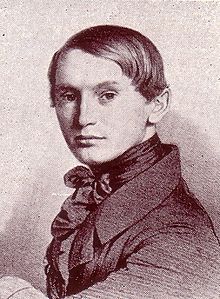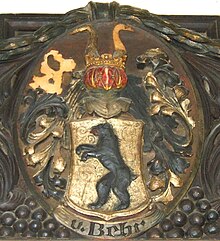Friedrich von Behr
Friedrich Karl Gustav Felix von Behr (born November 3, 1821 in Pinnow , Greifswald district ; † January 13, 1892 in Schmoldow , Greifswald district) was a Prussian landowner , politician and president of the German Fisheries Association .
Life
origin
He came from the old noble family von Behr and was the son of the landowner Hans Ludwig von Behr (1789–1837), lord of the Schmoldow, Vargatz, Pinnow and Johannishof estates (all districts of Greifswald), and his wife Juliane, née Homeyer (1797– 1847).
Landlord and modernizer of agriculture
Friedrich von Behr studied in Bonn and was a member of the Corps Borussia there . He then became the landowner on Schmoldow and Vargatz and a royal Prussian chamberlain .
Behr had traveled to England and the United States to familiarize himself with the latest developments in agriculture. Under the impression of these trips, he introduced the first drainage systems in German agriculture on his property. The merino sheep breeding he imported was widely recognized.
Friedrich von Behr had been chairman of the Baltic Central Beekeeping Association from 1872, which united beekeeping associations in what is now Western Pomerania. From 1876 to 1878 beekeeping associations from Mecklenburg were part of it.
He also earned the reputation of an expert in fish farming. As the successor to Georg Herbert Fürst Münster von Derneburg , Behr was president of the German Fisheries Association from 1873 to 1892 . During his presidency, the first international fishing exhibition was held in Berlin in 1880. With his support, the fishing areas of the fishing operations on Lake Constance were redefined. To thank him, the Lake Constance fishermen erected a monument on the island of Reichenau .
In May 1867 Friedrich von Behr received the first prize for the model of the workers' house in Schmoldow at the Paris World Exhibition . Of the total of three houses, one of the original is still preserved today.
In 1867 Behr moved into the spacious new mansion he had built in Schmoldow, which he had built in the neo-renaissance style and where he received visitors from home and abroad, including representatives of the diplomatic corps from Berlin.
In 1877 the Behrenhoffer and in 1878 the Behr Bandeliner received the Prussian title of Count. The old Friedrich von Behr rejected the increase in status , which applied to the whole family, however. That is why the various Behrschen coat of arms variants can be found in the district building of the district of Greifswald, where the coat of arms friezes of the district council members (24 lords and three cities) were attached.
politics
From 1867 to 1873 Behr was a member of the Prussian House of Representatives for the Stralsund 2 constituency. Initially, he was there as a member of the Conservative Party , but later switched to the Reich and Free Conservative Party (RFKP). From 1877 until his death (1892), Behr was a member of the Prussian manor house at the presentation of the old and fortified properties in the rural district of Neuvorpommern and Rügen .
From 1871 to 1884 he was a member of the German Reichstag as a member of the German Reich Party . For the first electoral term he was elected in the constituency of Stralsund 2 (Grimmen-Greifswald) and then in the Stralsund 1 (Rügen - Stralsund city) constituency.
Marriage and offspring
On August 4, 1848 Frederick married Behr in Wolgast his cousin Marie Homeyer (August 28 * 1828 in Wolgast; † 17 August 1920 Good Schmoldow), daughter of the big merchant and secretly Kommerzienrats Wilhelm Homeyer and his wife Wilhelmine, born of Schubert.
The couple had two daughters, among whom the property was shared after the death of all three sons:
- Julie Karoline Wilhelmine Marie von Behr (1849-1918) became the heiress of Vargatz, who was separated from Schmoldow: Since April 2, 1872, she was married to the Prussian officer Oscar von Nolte (1835-1913). The son Johannes Ludwig Friedrich Felix von Nolte (1877-1959) emerged from the marriage. Due to the wedding, Nolte Gutsherr auf Vargatz ,
- Anna Julie Mathilde Helene Carola Charlotta (1865–1896) inherited the downsized Schmoldow. On September 22, 1885 she married the first lieutenant in the 2nd Brandenburg Dragoon Regiment No. 12 in Gnesen and later general of the cavalry Friedrich von Rauch (1855-1935). Schmoldow inherited her daughter Elisabeth von Rauch (1893–1973), who was later to become Major a. D. Kurt von Storch (1890-1965) was married.
Cemetery in Vargatz
After his death on January 13, 1892, Behr was buried next to his parents in the Vargatzer cemetery. His wife Marie, daughters Anna and Julie and son-in-law Oscar von Nolte have also found their final resting place there. All graves are preserved.
See also
literature
- Genealogical manual of the nobility , noble houses A volume V, page 8, volume 29 of the complete series, CA Starke Verlag, Limburg (Lahn) 1962, ISSN 0435-2408
- Acta Borussica. Volume 6 / II (1867–1878), page 611 ( digitized version )
- Georg Hirth (Ed.): German Parliament Almanac. 10th edition, 1874
- Bernhard Mann (arrangement) with the collaboration of Martin Doerry , Cornelia Rauh , Thomas Kühne : Biographisches Handbuch für das Prussische Abrafenhaus 1867–1918 (= handbooks on the history of parliamentarism and political parties. Volume 3). Droste, Düsseldorf 1988, ISBN 3-7700-5146-7 .
Web links
- von Behr-Bargatz, Friedrich Felix in the database of members of the Reichstag
- Biography of Friedrich Karl Gustav von Behr-Schmoldow . In: Heinrich Best : database of the members of the Reichstag of the Empire 1867/71 to 1918 (Biorab - Kaiserreich)
Individual evidence
- ↑ Bernhard Mann (arrangement) with the assistance of Martin Doerry , Cornelia Rauh , Thomas Kühne: Biographisches Handbuch für das Prussische Abrafenhaus 1867–1918 (= handbooks on the history of parliamentarism and political parties. Volume 3). Droste, Düsseldorf 1988, ISBN 3-7700-5146-7 , p. 58.
- ↑ E. David (Ed.): Handbook for the Prussian manor house . Berlin 1911, p. 245 ( online ).
- ^ Fritz Specht, Paul Schwabe: The Reichstag elections from 1867 to 1903. Statistics of the Reichstag elections together with the programs of the parties and a list of the elected representatives. 2nd Edition. Carl Heymann Verlag, Berlin 1904, pp. 53–54.
- ↑ Marcelle and Fritz von Behr: Documents and research on the history of the Behr family, Gützkower line (Die Schwanenhälsigen). Volume VII, Part I and II, Bremen 1989. Document number: 2485
| personal data | |
|---|---|
| SURNAME | Behr, Friedrich von |
| ALTERNATIVE NAMES | Behr, Friedrich Karl Gustav Felix von (full name) |
| BRIEF DESCRIPTION | German landowner and politician, MdR |
| DATE OF BIRTH | November 3, 1821 |
| PLACE OF BIRTH | Pinnow , Greifswald district |
| DATE OF DEATH | January 13, 1892 |
| Place of death | Schmoldow , Greifswald district |




